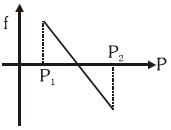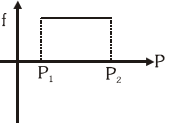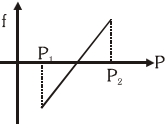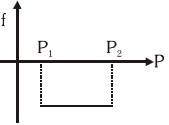Physics-
General
Easy
Question
A block of mass m is on an inclined plane of angle null. The block is held stationary by applying a force P parallel to the plane. The direction of force pointing up the plane is taken to be positive. As P is varied from
 to
to the frictional force f versus P graph will look like
the frictional force f versus P graph will look like





The correct answer is: 
Related Questions to study
physics-
A mass ‘m’ is supported by a massless string wound around a uniform hollow cylinder of mass m and radius R. If the string does not slip on the cylinder, with what acceleration will the mass fall on release?

A mass ‘m’ is supported by a massless string wound around a uniform hollow cylinder of mass m and radius R. If the string does not slip on the cylinder, with what acceleration will the mass fall on release?

physics-General
physics-
Two fixed frictionless inclined planes making an angle  and
and  with the vertical are shown in the figure. Two blocks A and B are placed on the two planes. What is the relative vertical acceleration of A with respect to B ?
with the vertical are shown in the figure. Two blocks A and B are placed on the two planes. What is the relative vertical acceleration of A with respect to B ?

Two fixed frictionless inclined planes making an angle  and
and  with the vertical are shown in the figure. Two blocks A and B are placed on the two planes. What is the relative vertical acceleration of A with respect to B ?
with the vertical are shown in the figure. Two blocks A and B are placed on the two planes. What is the relative vertical acceleration of A with respect to B ?

physics-General
physics-
The upper half of an inclined plane with inclination null= 0.5]
The upper half of an inclined plane with inclination null= 0.5]
physics-General
maths-
The tangent and the normal at a point P on an ellipse meet its major axis in T and T' so that TT' = a. Prove that the eccentricity angle  of P is given by :
of P is given by :  (where e is eccentricity of the ellipse) is equal to -
(where e is eccentricity of the ellipse) is equal to -
The tangent and the normal at a point P on an ellipse meet its major axis in T and T' so that TT' = a. Prove that the eccentricity angle  of P is given by :
of P is given by :  (where e is eccentricity of the ellipse) is equal to -
(where e is eccentricity of the ellipse) is equal to -
maths-General
maths-
maths-General
physics-
For the indicator diagram given below, select wrong statement

For the indicator diagram given below, select wrong statement

physics-General
physics-
Two blocks of masses  and
and  are connected with a massless spring and placed over a plank moving with an acceleration ‘a’ as shown in figure. The coefficient of friction between the blocks and platform is
are connected with a massless spring and placed over a plank moving with an acceleration ‘a’ as shown in figure. The coefficient of friction between the blocks and platform is  .
.

Two blocks of masses  and
and  are connected with a massless spring and placed over a plank moving with an acceleration ‘a’ as shown in figure. The coefficient of friction between the blocks and platform is
are connected with a massless spring and placed over a plank moving with an acceleration ‘a’ as shown in figure. The coefficient of friction between the blocks and platform is  .
.

physics-General
maths-
maths-General
physics-
A given mass of a gas expands from the state A to the state B by three paths 1,2 and 3 as shown in the figure If W1, W2 and W3 respectively be the work done by the gas along the three paths then

A given mass of a gas expands from the state A to the state B by three paths 1,2 and 3 as shown in the figure If W1, W2 and W3 respectively be the work done by the gas along the three paths then

physics-General
physics-
Same spring is attached with 2kg, 3kg and 1 kg blocks in three different cases as shown in figure. If  and
and  be the extensions in the spring in these three cases then
be the extensions in the spring in these three cases then

Same spring is attached with 2kg, 3kg and 1 kg blocks in three different cases as shown in figure. If  and
and  be the extensions in the spring in these three cases then
be the extensions in the spring in these three cases then

physics-General
physics-
If masses are released from the position shown in figure then time elapsed before mass m1 collides with the floor will be :

If masses are released from the position shown in figure then time elapsed before mass m1 collides with the floor will be :

physics-General
physics-
A block A of mass m is placed over a plank B of mass 2m. Plank B is placed over a smooth horizontal surface. The coefficient of friction between A and B is 0.5. Block A is given a velocity v0 towards right. Acceleration of B relative to A is

A block A of mass m is placed over a plank B of mass 2m. Plank B is placed over a smooth horizontal surface. The coefficient of friction between A and B is 0.5. Block A is given a velocity v0 towards right. Acceleration of B relative to A is

physics-General
physics-
In figure shown, both blocks are released from rest. The time to cross each other 
In figure shown, both blocks are released from rest. The time to cross each other 
physics-General
physics-
A block A is placed over a long rough plank B of same mass as shown in figure. The plank is placed over a smooth horizontal surface. At time t=0, block A is given a velocity v0 in horizontal direction. Let  and
and  be the velocities of A and B at time t. Then choose the correct graph between
be the velocities of A and B at time t. Then choose the correct graph between  or
or  and t
and t

A block A is placed over a long rough plank B of same mass as shown in figure. The plank is placed over a smooth horizontal surface. At time t=0, block A is given a velocity v0 in horizontal direction. Let  and
and  be the velocities of A and B at time t. Then choose the correct graph between
be the velocities of A and B at time t. Then choose the correct graph between  or
or  and t
and t

physics-General
physics-
Three blocks A , B and C of equal mass m are placed one over the other on a smooth horizontal ground as shown in figure. Coefficient of friction between any two blocks of A,B and C is  The maximum value of mass of block D so that the blocks A, B and C move without slipping over each other is
The maximum value of mass of block D so that the blocks A, B and C move without slipping over each other is

Three blocks A , B and C of equal mass m are placed one over the other on a smooth horizontal ground as shown in figure. Coefficient of friction between any two blocks of A,B and C is  The maximum value of mass of block D so that the blocks A, B and C move without slipping over each other is
The maximum value of mass of block D so that the blocks A, B and C move without slipping over each other is

physics-General



